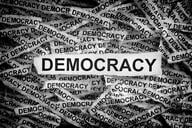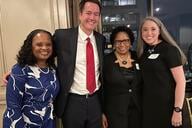You have /5 articles left.
Sign up for a free account or log in.
Colleges and universities continue to compete for attention across countless platforms; this scattershot approach often comes at the expense of cohesion. But simply adding more content—made easy within the decentralized environment of many campuses—isn’t a solution to deeper strategic and directional challenges. In the famous words of Merry Baskin, “Like a shark, brands must move forward or die.” For colleges and universities, that forward motion begins with centering courageous, strategic creativity as a core operating principle and with higher education marketing leaders creating a system to ensure all are moving in the correct direction.
I have argued that creativity continues to drive commercial value, however, investing in the intangible up front can be difficult when budgets remain static. So, our focus isn’t on only proving that creativity adds value but also showing how investing in it up front can maximize the value it creates. We need a framework for higher ed marketing leaders to establish a system for defining and embedding a culture of creativity across teams. This will help teams create more effective work and collaborate with agencies in support of institutional goals.
Modeled loosely on WARC’s creative effectiveness ladder, this three-phase framework should help marketing leaders not only spark creativity but also systematize it as a shared method. First, start by defining what creativity means within our unique institutional contexts instead of a loose collection of ideas. Then, develop the systems, roles and language that bring that definition to life. Finally, diffuse those practices across teams and departments to embed creativity into the fabric of institutional strategy.
Step 1: Define
Start by establishing the foundation for creative effectiveness by aligning on what creativity means, how it’s measured and why it matters. This will bring clarity to metrics, principles and strategic outcomes so creative work can be evaluated with purpose.
Create a shared set of key measures for creative effectiveness
Marketing leaders must establish clear, institution-specific indicators of what effective creativity looks like. No matter how rigorous the approach, consistent application and ensuring these measures are aligned are most important. Example measures include:
- Brand recall: Did prospective students or alumni remember the name of the institution after seeing an ad? This indicates a clear connection to the brand.
- Distinctiveness scores: In focus groups, ask audiences to compare your marketing to peer institutions—does your work stand out or feel generic? No matter the medium, attention is the first barrier to more effective work.
Determine principles of creative effectiveness
Determining principles of creative effectiveness means articulating the core beliefs and standards that guide all creative work across the institution. These principles serve as guardrails—ensuring that creativity remains consistent, purposeful and aligned with institutional values. When widely understood and adopted, they help teams evaluate work objectively and make more confident, collaborative decisions. Examples can be directional:
- Brand prominence: Brand or branding must be present within the first three seconds.
- Distinctive assets: Consistently use the school’s signature color palette, typeface and photographic style—even on social platforms—to maintain visual recognition. Stay on brand, not on trend.
- Commit to creativity: Use longer durations, more media channels and consistent storytelling over time to drive cumulative impact.
- Emotional truth wins: Campaigns should connect emotionally with audiences; stories of real students often outperform statistics.
Align key measures of effectiveness to marketing KPIs
Marketing leaders should evaluate creative work using engagement-based metrics—such as time on page, view-through rates, social saves and content shares. These go beyond impressions to signal true resonance and provide a shared set of indicators for what effective creativity looks like in practice.
Step 2: Develop
Once effectiveness is clearly defined, leadership should build the internal systems to support and scale it. This phase is about ensuring teams are equipped to execute in practice.
Identify critical roles within the institution
First develop a network of collaborators: content producers, enrollment leaders, advancement partners, institutional researchers and/or agency teams. Map out who holds creative influence across the institution and define the roles they play in shaping, supporting and evaluating creative work. Clarity will empower contributors and reinforce accountability.
Create a shared language for evaluation
Marketing leaders need a consistent, responsive way to evaluate creative work. By building in intentional check-ins throughout the creative process, teams can replace feelings with shared language that sharpens feedback and improves outcomes.
Leaders should consider three stages of evaluation:
- Pretest: Introduce a lightweight, consistent method to test creative ideas before launch. This might include quick student feedback loops, internal scoring rubrics or pilot testing in key markets.
- Platform: Centralize creative assets, guidelines and effectiveness learnings into a shared, accessible platform.
- Pulse: Establish a regular cadence for reviewing the performance of creative work both in-market and in internal perception.
Step 3: Diffuse
With creativity defined and the right systems in place, the final step is to diffuse that culture across the institution. To drive real institutional value, creative effectiveness must be shared, socialized and scaled across departments, disciplines and decision-makers.
Identify key working groups to deliver creativity workshops
Start by identifying key teams or departments—enrollment, advancement, student life, academic units—that shape public-facing messages or student experiences. Bring them into the fold through collaborative workshops that unpack creative principles, show examples of effective work and introduce shared evaluation tools.
Develop measurement frameworks aligned to department-level KPIs
Creativity becomes powerful when its effectiveness is measured in context. That means helping individual departments or units tie creative performance to their own goals—whether it’s growing attendance at student events, boosting open rates on fundraising emails or improving reputation scores for a new academic program. By co-creating simple measurement frameworks with each team, marketing leaders position creativity as a strategic asset.
Build a best-in-class repository for cross-campus learning
Finally, celebrate and scale what works. Create a living archive of standout creative work, from bold campaigns to scrappy social posts that have delivered results. Share the backstory: What was the challenge? What was the idea? What impact did it have? This becomes a source of inspiration, a tool for onboarding new team members and a tangible way to reinforce these new values.
By defining what creativity means, developing the systems to support it and diffusing its value across campus, marketing leaders can turn creativity into a measurable, repeatable driver of effectiveness.




